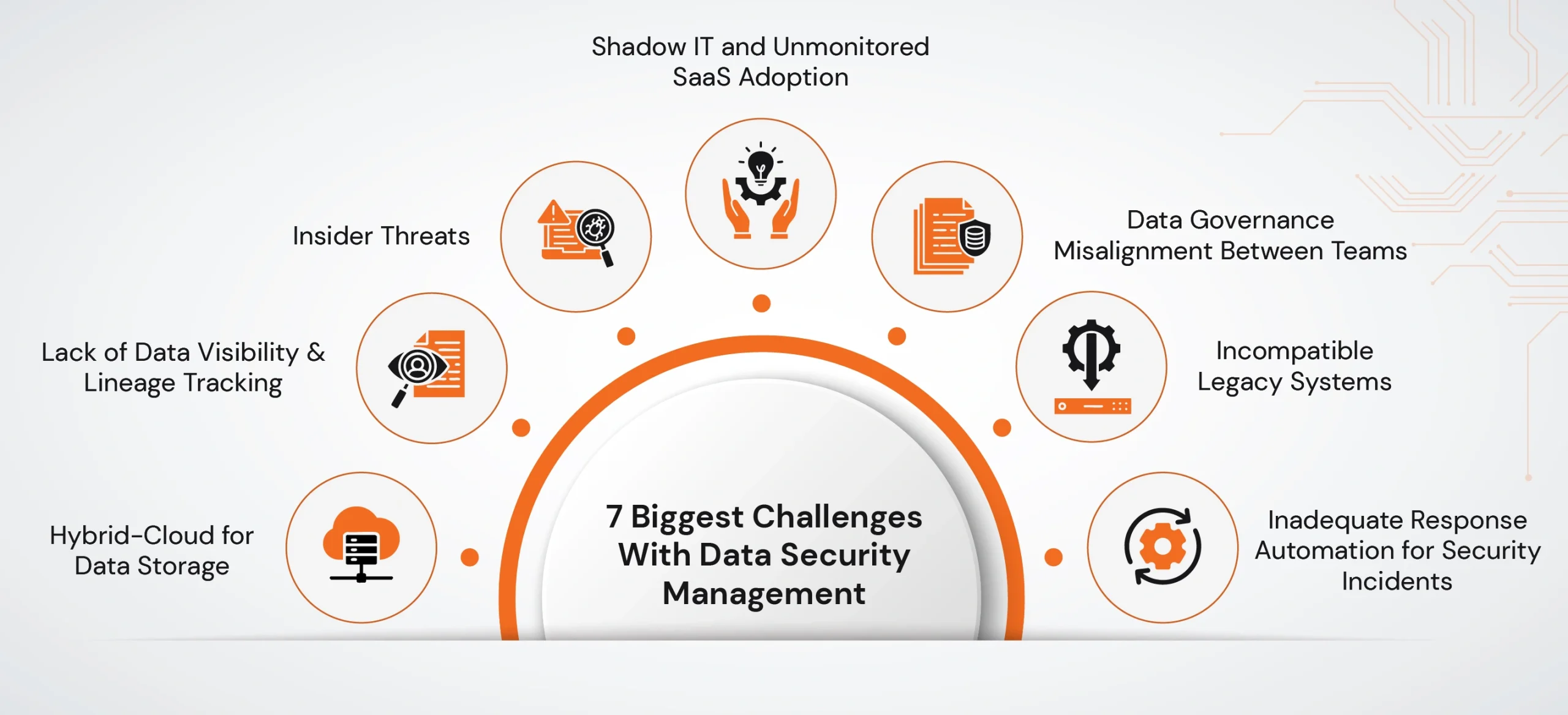In recent times, data has become the most valuable asset, predominantly after the widespread adoption of cloud computing, data modernization and next-gen technologies like artificial intelligence (AI), machine learning (ML), and others. This technological evolution drove efficiency, scalability, and flexibility for enterprises all over the globe. However, this transformation gave rise to new complexities related to data security management.
Data breach, leakage, loss, or corruption can lead any enterprise to a standstill, face financial loss, and legal consequences for neglecting adherence to regulations and compliance related to data security and management.
Data security management is crucial for enterprises with the emergence of new technologies, threats, and regulatory reforms. The massive growth of data volumes, multiple data sources, and diverse data formats has led to consequent challenges in data security management. For the data management services provider, it is not a simple task that can be resolved with a single tool or solution, and it involves multiple aspects that are challenging and complex. According to a report, in 2023 there were around 6.06 billion malware attacks globally, alarming rising need to protect data with more cautions and innovative approach. The data management companies face certain challenges that can be addressed using advanced technologies and strategic approaches.
7 Biggest Challenges Enterprises Face With Data Security Management
1. Hybrid-Cloud for Data Storage
Challenge: The variations in tools and configurations between cloud providers can make it challenging to maintain the consistency of security policies across hybrid platforms. Having an inconsistency in the security policy owing to different cloud platforms can make data vulnerable.
Additionally, different cloud providers could have different data security policies, making data security management complex and vulnerable. Complex interconnected networks and siloed data make businesses unable to extract actionable insights.
Solution: Implementing a Cloud Security Posture Management (CSPM) solution integrated with infrastructure-as-code (IaC) templates and policy-as-code frameworks like Open Policy Agent (OPA) can help solve such challenges and make data security more consistent. Deploying a unified data classification and encryption strategy with cloud-agnostic key management systems can help enterprises manage data security consistently.
2. Lack of Data Visibility and Lineage Tracking
Challenge: Inadequate data visibility and lack of lineage tracking make data security management weak and compromised. With a multi-cloud hybrid environment, it becomes challenging to have complete visibility of resources and configurations as data is stored across different networks. Without having precise knowledge about where the data is stored and how it’s utilized, it becomes challenging for enterprises to protect it. With no data lineage tracking, it becomes challenging and difficult to identify, assess, and mitigate data security risks. Data lineage is crucial because it helps track the origin, movement, and transformation of data, which is helpful during incidents of any data breach.
Solution: Adopting a Data Governance and Observability framework powered by metadata-driven data catalogs, automated data discovery tools, and end-to-end lineage tracking systems can help solve the challenge of poor data visibility and lineage tracking tools. By integrating these tools with multi-cloud architecture using APIs and connectors, leveraging data management companies’ capabilities.
3. Insider Threats
Challenge: Insider threat incidents are increasing with the rise of remote and hybrid work, making it difficult to monitor user activity cautiously. Hybrid cloud environments can have both on-premises and cloud resources, which makes data security management more difficult. Generally, it comprises multiple users, devices, and third-party vendors that access different resources, making it prone to insider threats. Additionally, during data movement in a multi-cloud environment, it becomes easier to access or extract the data.
Solution: Enterprises should implement a Zero Trust Security architecture combined with advanced User and Entity Behavior Analytics (UEBA) and Secure Access Service Edge (SASE) frameworks to mitigate insider threats. By using multi-factor authentication (MFA), just-in-time (JIT) access, and least privilege principles, leveraging data management services from experts. Deploying Data Loss Prevention (DLP) solutions and Encryption during data-in-transit and data-at-rest can help strengthen security against insider threats.
4. Shadow IT and Unmonitored SaaS Adoption
Challenge: Shadow IT, utilizing IT resources and unauthorized Software as a Solution (SaaS) applications without proper knowledge or approval, lacks required security measures, controls, and compliance. It leads to unmonitored and insecure data handling, as applications or IT resources often neglect standard security protocols, making it challenging to manage data security. Unmonitored SaaS applications and shadow IT may lack security measures, compliance, patching, data encryption, and proper access controls, making data vulnerable and exposed to data attackers.
Solution: Deploying a robust Cloud Access Security Broker (CASB) integrated with their security stack and gaining visibility into unauthorized applications can help mitigate the risk posed by shadow IT and unauthorized SaaS usage. Additionally, implementing endpoint detection and response (EDR) and an advanced SaaS Security Posture Management (SSPM) solution with data exfiltration controls helps restrict sensitive data movement across unapproved tools. Establishing a centralized SaaS governance policy and leveraging AI-driven anomaly detection models can help block high-risk SaaS access and manage data security. These measures are even more effective when paired with a well-executed cloud migration strategy focused on transformation and efficiency, ensuring scalable and secure infrastructure from the ground up.
5. Data Governance Misalignment Between Teams
Challenge: Data governance misalignment between teams creates inconsistencies in how data is classified, accessed, and protected across different platforms. It leads to scattered security policy implementations that are difficult to monitor and enforce uniformly, as every team will interpret it in their own way. The inconsistency in data governance can lead to inadequate data security, improper sharing, and data storage without encryption. Without aligned governance, it’s also challenging to detect and respond to security incidents effectively, as audit trails and controls may not be standardized.
Solution: Establishing a centralized data governance framework powered by automated policy enforcement and cross-platform orchestration tools can help resolve data governance misalignment across teams. Implementing a unified governance platform enables standardized data classification, access controls, and encryption policies across all teams.
6. Incompatible Legacy Systems
Challenge: Legacy systems comprise outdated architecture, lack security updates, and are incompatible with modern security measures. It uses less secure protocols and compromised encryption standards that can be easily breached. Many legacy systems have stopped receiving regular security patches or updates, exposing known data and new vulnerabilities. They might not be compatible with advanced security methodologies, measures, protocols, and tools such as firewalls and intrusion detection systems, further hindering data security and management.
Solution: Enterprises should adopt a layered security strategy while also planning for the gradual retirement or modernization of outdated infrastructure. Legacy systems should be isolated using network segmentation and protected through zero-trust network access. Data transmission can be safeguarded and exposure can be restricted with secure API gateways, virtual private networks (VPNs), and reverse proxies. Enterprises should implement a phased legacy modernization roadmap involving re-platforming, containerization, or refactoring to ensure compatibility with modern data security standards.
-
- See How We Modernized a Legacy CMS Without Compromising Security
Explore the Full Sitecore Legacy Upgrade Case Study
- See How We Modernized a Legacy CMS Without Compromising Security
7. Inadequate Response Automation for Security Incidents
Challenge: Lack of a robust and automated security incident response system exposes enterprises to significant risks. It makes organizations have delayed responses to security incidents and face challenges in timely incident detection and containment. Cyber threats and data breach patterns are evolving rapidly, and relying on traditional methods and waiting for human intervention is prone to delayed detection and response to mitigate or counteract security incidents.
Solution: Integrating data analytics , AI, and machine learning (ML) powered automated incident detection and response systems can help mitigate the risk associated with delayed security incident response. Implementing Security Orchestration, Automation, and Response (SOAR) systems and detecting anomalies leveraging ML algorithms and behavioral analytics, enterprises can react proactively, leveraging data management services.
Final Words
Enterprises need to deploy advanced data management strategies and technologies. This approach can help capitalize on the complete potential of the data assets. Data security and management is a multi-faceted approach. It includes multiple aspects that range from data identification, data classification to deploying appropriate technologies and tools.
As a leading data analytics services provider and go-to digital transformation partner, AQe Digital offers end-to-end data management services to protect your data using advanced technologies and innovative approaches.


